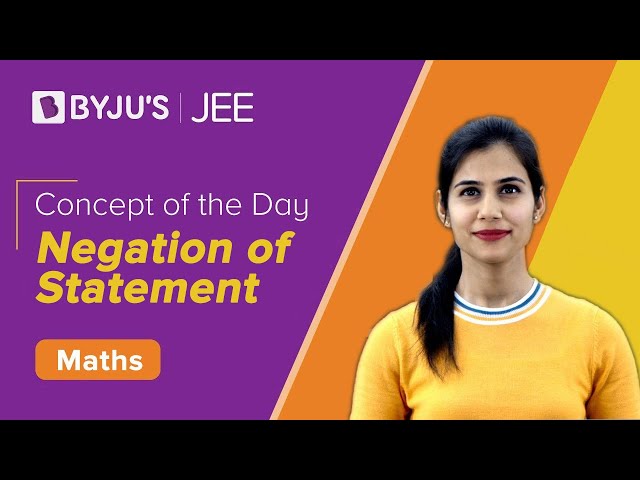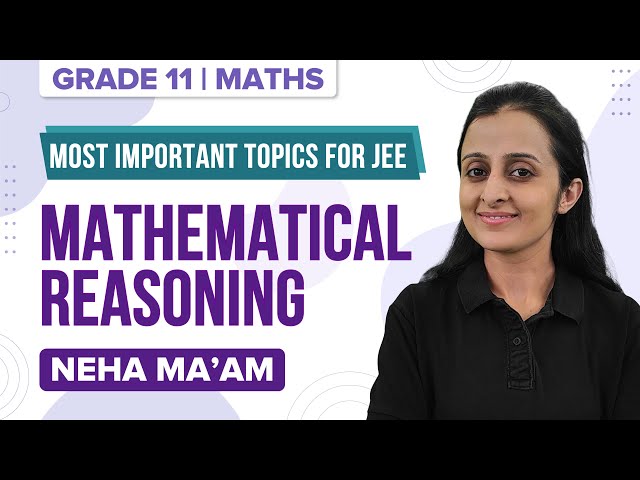Mathematical reasoning is a part of Mathematics where we determine the truth values of the given statements. Logical reasoning has a major role to play in our daily lives. For example, if a bag has balls of red, blue and black colour. And once a statement is made that all the balls that are coloured in red are being taken out of the bag means by logical reasoning that the available balls in the bag are of only blue and black colour. This article explains the topic of mathematical reasoning in an easy way.
Difference between Statement and Sentence in Logic
A statement is a sentence that is either true or false, but not both true and false simultaneously.
A sentence will not be considered to be a statement if:
It is an exclamation, order, request, and question and depicts time, places, and pronouns.
Consider the following examples:
| Sentence | Statement or not |
| Thrissur is the cultural capital of Kerala | Yes (as it’s true) |
| Get Out! | No (command) |
| Current is directly proportional to resistance | No (false statement) |
The statements can be either simple or compound statements. They are described as follows:
SIMPLE STATEMENT
If a statement cannot be further broken down into various statements, or in simpler words, if it is concrete by itself, it is called a simple statement.
Examples include:
- A kite is not a rhombus.
- 15 is an odd number.
COMPOUND STATEMENT
If a statement can further be broken down into simpler statements so that from a main statement, we can yield more than one statement, then it is called a compound statement.
Consider the statement “10 is non-negative and a multiple of 5”, which can be broken down into the statements: “10 is non-negative” and “10 is a multiple of 5”.
Basic Logical Connectivities
The words that are used to combine more than one simple statement from a compound statement are called connectives. Some of the common connectives are listed below:
| CONJUNCTION (represents English word AND) | Symbol: ^ |
| DISJUNCTION (=OR) | Symbol: v |
| NEGATION (=NOT) | Symbol: ~ |
For example:
Let p = Laptop has a keyboard.
And q = Clock has a needle
p^q = Laptop has a keyboard and clock has a needle is the conjunction statement.
p v q= Laptop has keyboard or clock has needle is the disjunction statement.
~p = Laptop has no keyboard
~q = Clock has no needle
Mathematical Reasoning Videos
Basic Logic Connectives

Negation of Statements

Conjunction, Disjunction and Negation
CONJUNCTION
- The statement p^q has the truth value T(true) if both p and q have the truth value T.
- Similarly, the statement p^q has the truth value F(false) if either p or q have the truth value F or both have the truth value F.
DISJUNCTION
- The statement pvq has the truth value F(false) if both p and q have the truth value F.
- Similarly, the statement pvq has the truth value T(true) if either p or q has the truth value T or both have the truth value T.
NEGATION
- ~p has truth value T whenever p has truth value F.
- ~p has truth value F whenever p has truth value T.
NEGATION OF COMPOUND STATEMENTS
The negation of a conjunction p ^ q is the disjunction of the negation of p and the negation of q.
~ (p ^ q) = ~p v ~q
Negation of the conjunction of “Laptop has keyboard and clock has no needle” is:
Laptop has no keyboard or clock has no needle.
The negation of a disjunction p v q is the conjunction of the negation of p and the negation of q.
~ (p v q) = ~p ^ ~q
Negation of disjunction of “Laptop has keyboard and clock has no needle” is:
Laptop has no keyboard and clock has no needle.
The negation of a statement is the statement itself.
~(~p)=p.
Conditional Statement and Its Converse
CONDITIONAL STATEMENT
If a connective “if then” is used to make the compound statement if p then q, it is a conditional statement; it is also called an implication and is written as p => q.
CONTRAPOSITIVE of a conditional statement is: ~q => ~p.
“If the laptop has a keyboard, then the clock has a needle” is the statement given to us.
Let p= “laptop has a keyboard”, and q= “clock has a needle”. The given statement is in the form p => q. Thus, its contrapositive is obtained by ~q=>~p.
It would be, “If the clock has no needle, then the laptop has no keyboard”.
CONVERSE OF A CONDITIONAL STATEMENT
If p=>q is a conditional statement, then its converse is q=>p.
Let the conditional statement be, “If the laptop has a keyboard, then the clock has a needle”.
Then, its converse would be obtained as: “If the clock has a needle, then the laptop has a keyboard”.
Truth Table for Logical Operations
AND operation:
| p | q | p ∧ q |
| T | T | T |
| T | F | F |
| F | T | F |
| F | F | F |
OR operation:
| p | q | p ∨ q |
| T | T | T |
| T | F | T |
| F | T | T |
| F | F | F |
Negation operation:
| p | ∼ p |
| T | F |
| T | F |
| F | T |
| F | T |
Conditional operation:
| p | q | p ⇒ q |
| T | T | T |
| T | F | F |
| F | T | T |
| F | F | T |
Biconditional operation:
| p | q | p ⇔ q |
| T | T | T |
| T | F | F |
| F | T | F |
| F | F | T |
Tautology and Fallacy
A tautology asserts that every possible interpretation has only one output, namely true.
On the other hand, fallacy implies an assertion of false in every possible interpretation.
There are infinitely many tautologies. Some of them are listed below:
- “A or not A” is called the law of excluded middle. This formula has only one propositional variable, A.
- A=>B 🡺 ~B=>~A, called the law of contraposition.
- ~(A ^ B) 🡺 ~A v ~B, called the De Morgan’s law.
- ((A=>B) ^ (B=>C)) 🡺 (A=>C), called the principle of Syllogism.
- ((A v B) ^ (A=> C) ^ (B=>C)) 🡺C, called the principle of proof by cases.
A minimal tautology is a tautology that is not the instance of a shorter tautology.
To evaluate tautology and fallacy, we can adapt the concept of the truth table that includes every possible valuation.
| p | q | p ⇒q | q ⇒p | (p⇒q)∨(q⇒p) | ∼{(p⇒q) ∨(q⇒p)} |
| T | T | T | T | T | F |
| T | F | F | T | T | F |
| F | T | T | F | T | F |
| F | F | T | T | T | F |
As mentioned earlier, a fallacy is faulty reasoning, using wrong moves. Fallacious arguments usually have the deceptive appearance of being valid arguments.
A fallacy is classified as formal and informal fallacies by their structure or content. Informal fallacies are again sub-classified into linguistic relevance through omission, intrusion, presumption, etc.
Fallacies may also be classified as verbal and material fallacies with reference to the process by which they occur.
General Logical Equivalences
It comprises the following laws:
- Idempotent Law
- p ∧ p ⇔ p
- Associative Law
- Commutative Law
- Distributive Law
- Identity Laws
- Complement Laws
- Absorption Law
- De-Morgan’s Law
- q
- q
- Involution Law
- p
Additional Important Points
Also, Read
Jee Main Maths Statistics Previous Year Questions with Solutions
Mathematical Reasoning – Important Topics

Frequently Asked Questions
What do you mean by a conjunction in mathematical reasoning?
A conjunction is a statement formed by adding two statements with the connector AND. The symbol for conjunction is ‘∧’, which is read as ‘and’.
What do you mean by a disjunction statement in mathematical reasoning?
A compound statement formed by joining two statements using the connector OR is called a disjunction statement. The symbol used is ‘∨’.
What do you mean by connectives?
The words that are used to combine more than one simple statement to form a compound statement are called connectives. Negation, conjunction and disjunction are some common connectives.

Comments